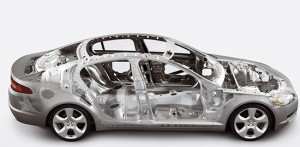Jaguar recently launched its new XF model to the world. Though 7-millimeters shorter and 3 mm lower than the car it replaces, the all-new XF has more rear space, more legroom, knee room and headroom. As is the case with any launch of a new car, enthusiasts just cannot stop raving about details such as horsepower, fuel consumption, and high-tech mumbo jumbo.

Aluminum Lightweighting
Yet, for metal analysts and, dare I say lovers (such as we her at MetalMiner), one thing about the new Jaguar XF that stands out is its weight. Or rather, the lack of it. The car, because of the extensive use of aluminum (75% in its overall architecture), is 190 kilograms lighter than its predecessor, and 80 kg lighter than some rivals. That includes a lighter engine, too, which, for car lovers, translates into high mileage and lower pollution.
So light is this new car that India’s Tata Motors has successfully completed “the longest suspension ride over water” at London’s Canary Wharf.
According to the report, “due to its low weight, the car sets new standards for fuel efficiency, boasting a consumption of less than four liters per 100 kilometers and emissions of 104 g/km of carbon dioxide.” The sportscar will be on display at the 2015 New York auto show, soon.
In one fell swoop, Tata Motors has shown the world what aluminum can do for sports cars. Lightening them and reducing fuel consumption on the large engine vehicles has been a challenge so far. Not that automakers in India, or for that matter, abroad, were unaware of the possibilities.
India is now home to automakers as diverse as Suzuki, Ford and Volkswagen and its own home-bred versions such as Maruti. All of these car companies are trying to keep up with the changing times. The last, for example, launched the Swift DZire diesel car recently, with reduced weight (lesser by 20 kgs) including a lighter fuel tank. Maruti went the extra mile by using plastic where possible instead of sheet metal.
Diversifying Automotive Materials
India’s aluminum producers, like their foreign counterparts, have increasingly started diversifying their client portfolio to include automakers, something unheard of about a decade ago, because it was all about steel back then.
What also gives this sector hope in India is the sustained global efforts to reduce greenhouse gas emissions, achievable, among other things, by reducing the fuel consumption of automobiles. Suddenly, lighter materials such as aluminum and auto-grade plastic do not seem so far-fetched. MetalMiner, too, has been updating its readers on developments on this front.
Cars are not the only auto products where aluminum is being used. Take one of India’s largest aluminum makers, Hindalco, the flagship firm of the Aditya Birla Group, for example. It already boasts of an all-aluminum truck body called Maxloader.
Ford has followed suit with an all-aluminum body for its F-150 pickup truck, thereby light-weighting it by as much as 318 kg. General Motors, too, is on the road to lighter vehicles, contemplating using a multimaterial approach, including lightweight steel, aluminum, magnesium and carbon fiber in its products.
The growth in India’s automobile sector has been one of the key drivers for its aluminum castings business. According to this report in LiveMint, India is one of the major producers and users of aluminum castings, globally, and castings account for around 30 to 35% of the total aluminum usage in the country.
No Longer Steel’s Second Violin
The metal’s future as “substitute competition” to steel seems set, encouraging leading producers including Hindalco-owned Novelis, to invest millions of dollars in research and development, and capacity expansion. Novelis, incidentally, was the supplier of aluminum sheets for the newly launched Jaguar XE.
Indian and global aluminum makers including Alcoa have been upbeat on the use of the light metal in the automotive sector, hoping it will shore up their bottom lines. They now expect a sustained growth in demand for aluminum in the coming years, with demand from the aerospace and automotive sectors steadily increasing. Suddenly, aluminum seems like it is no longer playing second fiddle to steel in automotive production.



